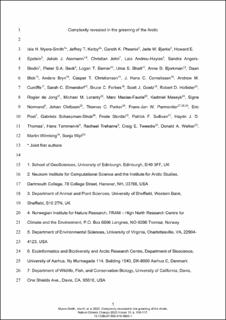| dc.contributor.author | Myers-Smith, Isla H. | |
| dc.contributor.author | Kerby, Jeffrey T. | |
| dc.contributor.author | Phoenix, Gareth K. | |
| dc.contributor.author | Bjerke, Jarle W. | |
| dc.contributor.author | Epstein, Howard E. | |
| dc.contributor.author | Assmann, Jakob J. | |
| dc.contributor.author | John, Christian | |
| dc.contributor.author | Andreu-Hayles, Laia | |
| dc.contributor.author | Angers-Blondin, Sandra | |
| dc.contributor.author | Beck, Pieter S. A. | |
| dc.contributor.author | Berner, Logan T. | |
| dc.contributor.author | Bhatt, Uma S. | |
| dc.contributor.author | Bjorkman, Anne D. | |
| dc.contributor.author | Blok, Daan | |
| dc.contributor.author | Bryn, Anders | |
| dc.contributor.author | Christiansen, Casper Tai | |
| dc.contributor.author | Cornelissen, J. Hans C. | |
| dc.contributor.author | Cunliffe, Andrew M. | |
| dc.contributor.author | Elmendorf, Sarah C. | |
| dc.contributor.author | Forbes, Bruce C. | |
| dc.contributor.author | Goetz, Scott J. | |
| dc.contributor.author | Hollister, Robert D. | |
| dc.contributor.author | de Jong, Rogier | |
| dc.contributor.author | Loranty, Michael M. | |
| dc.contributor.author | Macias-Fauria, Marc | |
| dc.contributor.author | Maseyk, Kadmiel | |
| dc.contributor.author | Normand, Signe | |
| dc.contributor.author | Olofsson, Johan | |
| dc.contributor.author | Parker, Thomas C. | |
| dc.contributor.author | Parmentier, Frans-Jan W. | |
| dc.contributor.author | Post, Eric | |
| dc.contributor.author | Schaepman-Strub, Gabriela | |
| dc.contributor.author | Stordal, Frode | |
| dc.contributor.author | Sullivan, Patrick F. | |
| dc.contributor.author | Thomas, Haydn J.D. | |
| dc.contributor.author | Tømmervik, Hans | |
| dc.contributor.author | Treharne, Rachael | |
| dc.contributor.author | Tweedie, Craig E. | |
| dc.contributor.author | Walker, Donald A. | |
| dc.contributor.author | Wilmking, Martin | |
| dc.contributor.author | Wipf, Sonja | |
| dc.date.accessioned | 2020-04-01T10:41:32Z | |
| dc.date.available | 2020-04-01T10:41:32Z | |
| dc.date.created | 2020-02-03T09:26:01Z | |
| dc.date.issued | 2020 | |
| dc.identifier.citation | Nature Climate Change. 2020, 10 106-117. | en_US |
| dc.identifier.issn | 1758-678X | |
| dc.identifier.uri | https://hdl.handle.net/11250/2649857 | |
| dc.description.abstract | As the Arctic warms, vegetation is responding, and satellite measures indicate widespread greening at high latitudes. This ‘greening of the Arctic’ is among the world’s most important large-scale ecological responses to global climate change. However, a consensus is emerging that the underlying causes and future dynamics of so-called Arctic greening and browning trends are more complex, variable and inherently scale-dependent than previously thought. Here we summarize the complexities of observing and interpreting high-latitude greening to identify priorities for future research. Incorporating satellite and proximal remote sensing with in-situ data, while accounting for uncertainties and scale issues, will advance the study of past, present and future Arctic vegetation change. | |
| dc.language.iso | eng | en_US |
| dc.title | Complexity revealed in the greening of the Arctic | en_US |
| dc.type | Peer reviewed | en_US |
| dc.type | Journal article | en_US |
| dc.rights.holder | © 2020, Springer Nature Limited | |
| dc.description.version | acceptedVersion | |
| cristin.ispublished | true | |
| cristin.fulltext | postprint | |
| cristin.qualitycode | 2 | |
| dc.identifier.doi | 10.1038/s41558-019-0688-1 | |
| dc.identifier.cristin | 1790014 | |
| dc.source.journal | Nature Climate Change | en_US |
| dc.source.volume | 10 | en_US |
| dc.source.pagenumber | 106-117 | en_US |
| dc.relation.project | Norges forskningsråd: 274711 | en_US |
| dc.relation.project | Norges forskningsråd: 287402 | en_US |
| dc.relation.project | Svalbards miljøvernfond: 17/37 | en_US |
| dc.relation.project | Norges forskningsråd: 294948 | en_US |
| dc.relation.project | Andre: Swedish Research Council registration 2017-05268 | en_US |
| dc.relation.project | Norges forskningsråd: 230970 | en_US |
| dc.subject.nsi | VDP::Zoologiske og botaniske fag: 480 | |
| dc.subject.nsi | VDP::Zoology and botany: 480 | |
